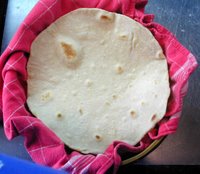
Today I'm going to do a show and tell about how I make tortillas de harina (flour tortillas). This is by no means instructions for authentic Honduran flour tortillas, because I'm not talented enough to make those perfectly round disks by flapping the dough back and forth in my hands.
This is my Americanized version but it is pretty darn good. You can get very close to a Honduran tortilla if you shape the dough thicker than I do.
First I'll give the basic recipe and then I'll give more detailed instructions along with some information about how Honduran women traditionally prepare tortillas.
La Gringa's Honduran-American Tortillas
Approximately 20 6" tortillas
4 cups all purpose white flour
2 tsp. salt
2 tsp. baking powder
4 tbsp. manteca (hydrogenated vegetable oil)
1 1/4 cups or more water
Measure the flour into a large bowl. Add salt and baking powder and mix with spoon or pastry cutter. Add manteca and cut into flour with pastry cutter or fork until the bits of manteca are no longer visible.
Add most of the water and mix with a large spoon until all the water is absorbed. Add up to 1/4 cup more water if dough seems stiff or dry. Turn dough onto floured surface and knead about 50 times until the dough is smooth and begins to bubble. Cover the dough and let it rest about 15 minutes.
After the rest period, tear off pieces of dough and roll in your hands into smooth balls, about 20 for 6" tortillas. Cover the balls with plastic or a towel and let them rest again for about 15 minutes.
Shape the tortillas and bake them on a hot griddle or cast iron skillet for 1-2 minutes on each side until a few browned spots (freckles) appear. Keep warm in a towel-lined basket until ready to serve.
__________
Ingredients
It was tough to find a recipe as NO ONE measures the ingredients. When I first tried to find a tortilla recipe, some women told me to use baking soda, some women said baking powder, and some said to use either one. Some said "you know, the powder in the yellow bag." Well, they both can be purchased in yellow bags. I didn't think the two were interchangeable, but apparently they are in Honduran tortillas.
 I found that the dough made with baking soda tended to bounce back into a smaller circle no matter how much I stretched it, so I much prefer using baking powder. An interesting thing is that most Mexican tortillas recipes I've seen don't call for any leavening.
I found that the dough made with baking soda tended to bounce back into a smaller circle no matter how much I stretched it, so I much prefer using baking powder. An interesting thing is that most Mexican tortillas recipes I've seen don't call for any leavening.The white flour available here usually says on the package "mejor para baleadas" (better for tortillas) or "mejor para pan" (better for bread). I've noticed that the "better for tortillas" flour has 11% protein so I think that is the equivalent of an all-purpose soft wheat flour. I have substituted 1/2 to 1 cup of whole wheat flour when I can find it. It adds a nice flavor.
The dictionary definition of manteca includes butter, lard, and oil but manteca in Honduras is a hydrogenized palm oil that comes in tubes. The one I use is partly corn oil and that's why it is yellow instead of pure white like most mantecas. It may be available in Latino grocery stores in the U.S. If it isn't available in your area, I suppose you could use shortening, although products such as Crisco are softer than manteca. If you keep manteca in the refrigerator, you have to cut it with a knife. It is that hard. Many Mexican tortilla recipes call for lard and say that there is no substitute.
Mixing the dough
Many Honduran women mix the dough entirely with their hands directly on the countertop. This is very messy and the manteca is almost impossible to wash from your hands.

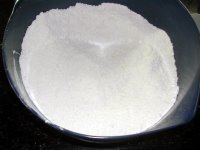

I always say that bread dough should feel like a baby's butt. Tortilla dough should be a little softer than that but not sticky. During the mixing stage, add more water if the dough seems too dry or more flour if the dough seems too sticky. The flour does not have to be completely incorporated into the dough at this point.
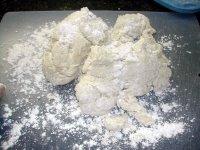


You can add a bit of water or flour during the kneading stage if you find you have misjudged the consistency. If the dough sticks to your hands or the pastry sheet while kneading, sprinkle both with more flour. The first rest period is not crucial − Some women skip it or leave the covered dough for hours or even put it in the refrigerator until the next day.
Shaping the balls of dough

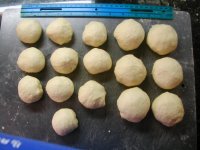
For a thin 6" (15 cm.) tortilla, I use about 2 oz. of dough. For a larger tortilla, like for burritos, I use up to 4 oz. For thick Honduran-style tortillas, use about 3 oz. This picture shows a 2 oz., 3 oz., and 4 oz. ball from right to left (62, 85, 113 g.). They measure about 1 3/4", 2", and 2 1/4", respectively (4.5, 5, 5.75 cm.). This recipe makes about 40 oz. of dough (1.13 kg.), about 20 small or 10 very large tortillas.
Don't worry. They don't have to be exact. These measurements are just to give you an idea. If you have a little piece of dough left over, use it for your first practice tortilla.
The second rest period is important as it helps to relax the dough balls making it much easier to shape the tortillas. Because it takes some time to make the dough balls, shape the tortillas, and cook each one individually, some Hondurans do not bother to let the dough rest before starting. Most of the dough will get the required resting period just because it takes so long to make them.
Shaping the tortillas
For authentic Honduran tortillas, you would need to slap the dough back and forth between your hands and end up with perfect circles of exactly the same size every time. I can not do this, so I'll show you my easier Americanized version.
Cut several 10" circles from heavy plastic. I have a bunch because I like to make tortillas assembly-line style. I keep my plastic circles in a zip lock sandwich bag and use them over and over again. By the way, I've tried using wax paper and the paper is not strong enough. If you don't have any good strong Honduran grocery bags to cut up, you could cut up some zip lock freezer bags.
 If you use a flimsier plastic, the dough will "pull" the plastic as it contracts, resulting in wrinkles like in this picture. The stiffer the plastic, the easier it will be to shape the tortilla and to release the dough from the plastic.
If you use a flimsier plastic, the dough will "pull" the plastic as it contracts, resulting in wrinkles like in this picture. The stiffer the plastic, the easier it will be to shape the tortilla and to release the dough from the plastic. 

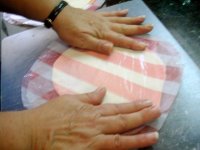


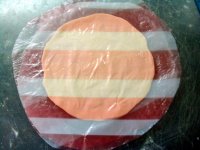
Place one dough ball on a circle of plastic. Cover with another circle of plastic. Begin stretching the dough by pushing outward from the center of the ball with your fingertips or the side of your hand, turning the plastic as you push to keep the dough round. If the dough bounces back after stretching, that means it needs a longer rest period.
When the dough is of an even thickness in the size that you desire, it's ready to cook. The thing to remember is that the tortilla will shrink about an inch (2.5 cm.) while cooking.
Tips
I recommend preparing half the recipe on your first try. I also recommend smaller and thicker tortillas for your first attempt. The larger and thinner the tortillas are, the harder it is to handle the dough without it folding over on itself, as it did in the picture below. This was partly because my kitchen was so hot today and because the dough was sitting out in the heat longer than usual while I took pictures. I actually had to put the dough in the refrigerator to firm it up, but this shouldn't be a problem in an air conditioned kitchen.
It really made me mad that my tortillas didn't turn out perfect today, the one time when I was taking pictures!
Baking the tortillas

 Preheat a griddle or iron skillet. My griddle has to be set at the highest temperature, 425°F (220°C). Carefully pull the top plastic off. Drape the tortilla dough side over your left hand and gently pull off the remaining plastic with your right hand. This takes a little practice. If you mess up the dough, roll it back into a ball and let it rest again for at least 5-10 minutes.
Preheat a griddle or iron skillet. My griddle has to be set at the highest temperature, 425°F (220°C). Carefully pull the top plastic off. Drape the tortilla dough side over your left hand and gently pull off the remaining plastic with your right hand. This takes a little practice. If you mess up the dough, roll it back into a ball and let it rest again for at least 5-10 minutes.Using both hands, carefully place the tortilla onto the griddle − being careful not to burn your fingers and careful that the tortilla is placed flat. If you work fast, you can push and stretch the dough if needed to shape a neater circle after it has been placed on the griddle. If part of it folds over onto itself, try to push that area flat so it will cook properly.
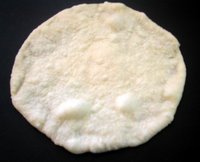
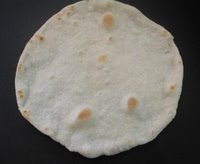
 Cook for 1-2 minutes or until the top is bubbly and the bottom begins to show a few golden brown spots. Turn with a spatula. Honduran women turn the tortillas with only their fingers. Ouch! Cook the other side until it, too, has a few brown spots. The tortilla should look dry, not doughy. Turn again and cook a little longer, if necessary.
Cook for 1-2 minutes or until the top is bubbly and the bottom begins to show a few golden brown spots. Turn with a spatula. Honduran women turn the tortillas with only their fingers. Ouch! Cook the other side until it, too, has a few brown spots. The tortilla should look dry, not doughy. Turn again and cook a little longer, if necessary.They cook very fast so if you are busy doing something else for more than a minute, they may burn. If the tortilla does not 'freckle' in 2 minutes, that means that your pan is not hot enough and you will end up with a dry crispy cracker instead of a tortilla. (Ask me how I know.) El Jefe and our former worker Carlos had a few laughs over my first attempts, but when they began eating 10-12 tortillas with lunch, I knew I finally had it down pat.
 Most Honduran women use a small pan called a comal and cook them one at a time. I like to use a griddle and cook several at a time. Tortillas cook faster on a comal than on my griddle, so if you use a comal or a cast iron skillet, go by the look of the tortilla, not the time I have specified. Don't use your best non-stick saute pan for this − the temperature needs to be too high and since the pan will be empty part of the time, the high heat will ruin your pan. Trust me on this.
Most Honduran women use a small pan called a comal and cook them one at a time. I like to use a griddle and cook several at a time. Tortillas cook faster on a comal than on my griddle, so if you use a comal or a cast iron skillet, go by the look of the tortilla, not the time I have specified. Don't use your best non-stick saute pan for this − the temperature needs to be too high and since the pan will be empty part of the time, the high heat will ruin your pan. Trust me on this.As the tortillas cook, place them in a tortilla warmer or a basket lined with a kitchen towel. They will stay warm for quite awhile. In Honduras, tortillas are usually served plain or filled with part of the meat and/or beans from the plate. We sometimes like to eat them folded around a bit of butter or salsa picante (hot sauce), Tex-Mex style. Especially when they are hot from the griddle − mmmm.
These tortillas keep very well in a ziplock bag in the freezer. When ready to use, remove from freezer, place in a towel-lined basket and let thaw a few minutes. Heat in microwave for 20-30 seconds, depending on quantity. Don't heat too long or the tortillas will be tough. They can also be wrapped in foil and reheated in the oven.
Making tortillas is a very labor intensive project. Many Honduran women make tortillas three times a day and have families of 6 to 8 to 10 people, so you can imagine how much time they spend over that hot stove. Often tortillas are made over wood burning stoves, so women suffer from the smoke as well as the heat, often getting respiratory infections and even tuberculosis. The Peace Corps and Trees, Water, & People are two of several organizations that works to provide fuel efficient, more healthful wood burning stoves to the poor of Central America.
Corn tortillas are served more often in Honduras than flour tortillas, especially in the mountain areas. I noticed that the maids I have had over the years always make the kind of tortilla (corn or flour) that they like best and claim not to know how to make the other. Amusing, huh? But when I offer to teach them, they always seem to remember. I guess the shame of having a gringa (woman from the U.S. or England) teach them how to make tortillas would be just too much to bear. ;-D
Your corn tortilla lesson will have to be another day, but don't worry, corn tortillas are easier.


 Welcome to my Blogicito —
Welcome to my Blogicito — 







